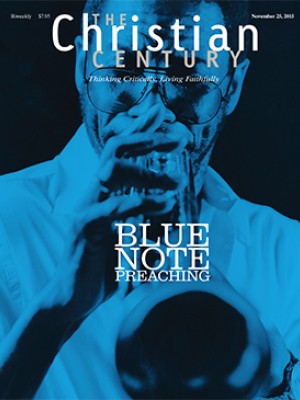Iraqi artists lead efforts to preserve musical past damaged by war
(The Christian Science Monitor) In an antique stall near al-Mutanabbi Street, the shop owner wipes the dust off a brittle black disc, winds up a gramophone, and plays the multilayered melodies and melancholy lyrics that are part of Iraq’s vanishing musical history.
The coffeehouses ringing the street of booksellers are still full of Iraqis, but the tradition that brought diverse communities together to listen to music in them is long gone. So, too, is the national archive of music and sound that was destroyed in 2003.
Read our latest issue or browse back issues.
In the region where the world’s first musical instruments are believed to have appeared, musical heritage is under siege from war, upheaval, and religious fundamentalism.
The earliest known recordings were done on wax cylinders, including dozens of recordings of music produced in 1908 in Jeddah, almost unthinkable today in religiously conservative Saudi Arabia. Mosul and other parts of Iraq with rich musical traditions are now under the control of the self-described Islamic State, which bans music.
Despite the ongoing war against IS and the difficulty of daily life in Baghdad, some young Iraqi musicians are trying to revive the music their parents and grandparents listened to.
Zaidoun Hussein, a recent graduate of Baghdad’s Music and Ballet School, is modernizing some of the traditional songs for young listeners more interested in jazz and hip-hop. His cover version of Iraqi Jewish singer Filfil Gurgi’s half-century-old lovelorn song “Ach Minak” (roughly translated as “What you’ve done to me”) has the appeal of modern pop music.
“The young guys don’t listen to this music so I had the idea of putting it to new music so it’s not lost,” he said. “I want young people to know the Iraqi musical legacy.”
Rolf Killius, a London-based ethnomusicologist, is encouraging Iraqi collectors to establish a trust that would house a new sound archive of traditional music.
“When you look at the 1930s, ’40s, and ’50s,” Killius said, “Baghdad, Damascus, and Cairo were the centers of the Arab world.”
Shellac recordings, produced from the 1920s to the 1960s before being replaced by vinyl, helped forge that shared musical culture.
“For the first time, it became possible to listen to music in a different place, so it was possible to listen in Baghdad to music from the south,” he said.
The preeminent Iraqi musical tradition was maqam, performed at the homes of patrons and in coffeehouses in Baghdad, Basra, Kirkuk, and Mosul. Based on poetry, each song has several lengthy sections and features an interplay of vocal improvisation with musical accompaniment on traditional instruments.
Iraqi maqam, listed by UNESCO as part of the world’s intangible cultural heritage, reflected the cultural mosaic of Iraqi cities with Turkish, Persian, and Kurdish influences. Many of the musicians were Jewish or Christian.
“Iraqi maqam is difficult to sing and a bit difficult to listen to as well,” said Abdul Razzaq al-Azzawi of Iraq’s National Symphony Orchestra. “There are about 75 different songs in Iraqi maqam. To be considered a maqam singer you have to know at least half of them. “
When shellac recordings, made from a compound based on beetle shells, became popular in the 1920s, coffeehouse owners played the records on huge gramophones.
British and German recording companies made early recordings in Baghdad hotel rooms. But an Iraqi company, Chakmakchi, established in 1918, recorded most of the Iraqi music that followed. The establishment of Iraqi state radio two decades later helped build up a large archive of Arab, Kurdish, and Turkmen music.
That archive, along with the Center for Traditional Music in the Iraqi culture ministry, was damaged and looted in 2003. Many of the surviving recordings are now in the hands of private collectors.
“I don’t know how Iraqis can preserve this music,” said Scheherazade Hassan, whose thousands of field recordings in the 1970s established the Center for Traditional Music.
Hassan, a Paris-based ethnomusicologist, said that when the culture ministry roof collapsed due to air strikes in 2003 she was unable to get any information from UN or Iraqi authorities about what had happened to any of the sound archives.
The archives contained 4,000 recordings with 2,000 hours of music recorded across Iraq between 1971 and 1977 as well as photographs, notes, and musical transcriptions.
“After the war many of these things are gone, nobody knew how or where or what happened to them,” said al-Azzawi of the symphony orchestra. “I saw and listened to so many of them. When I went after to the library to listen to them I found only the cover, and the reel is not there. It is a disaster.”
Killius’s suggestion of a new sound archive, meanwhile, has few prospects for official support. The cash-strapped government has other priorities and little interest.
In the meantime Killius has come to Iraq for a workshop sponsored by Ruya, the foundation for contemporary Iraqi culture. The project, called One Baghdad, will eventually be a website to which Iraqis across Baghdad can send in music or other sounds they’ve recorded of the city. The audio files will be linked to a map of Baghdad.
Furat al Jamil of the Ruya Foundation said even in the last few decades the sound of birds and the sound of the wind in the palm trees has diminished in Baghdad.
“Iraq is rich with music and sounds, and it’s a shame that a lot of it gets lost in time,” she said.
This article was edited on November 12, 2015.





